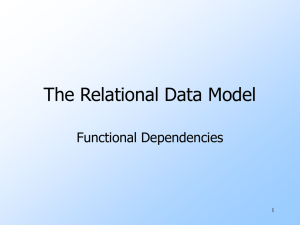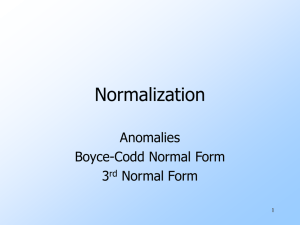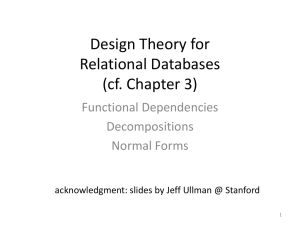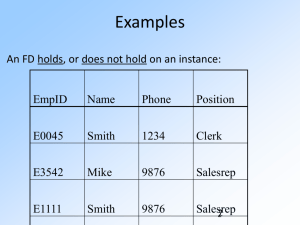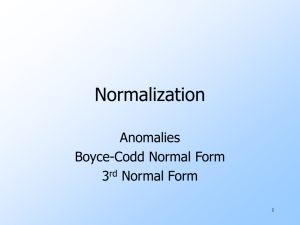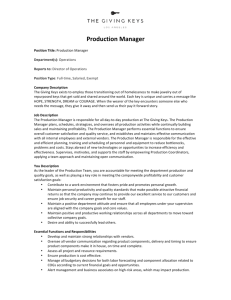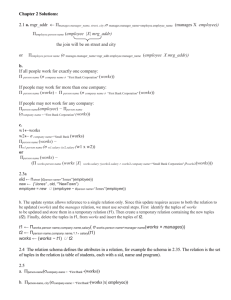ppt
advertisement
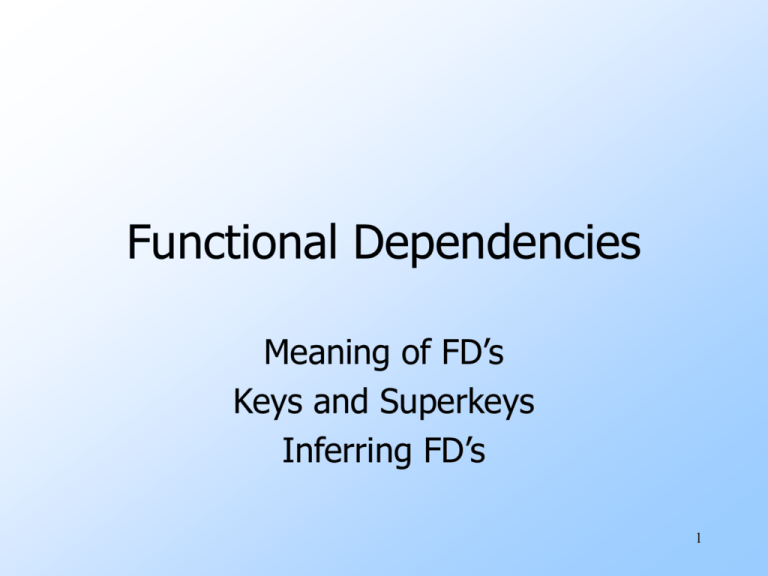
Functional Dependencies
Meaning of FD’s
Keys and Superkeys
Inferring FD’s
1
Functional Dependencies
X -> A is an assertion about a relation R
that whenever two tuples of R agree on all
the attributes of X, then they must also agree
on the attribute A.
Say “X -> A holds in R.”
Convention: …, X, Y, Z represent sets of
attributes; A, B, C,… represent single attributes.
Convention: no set formers in sets of attributes,
just ABC, rather than {A,B,C }.
2
Example
Drinkers(name, addr, beersLiked, manf,
favBeer)
Reasonable FD’s to assert:
1. name -> addr
2. name -> favBeer
3. beersLiked -> manf
3
Example Data
name
Janeway
Janeway
Spock
addr
Voyager
Voyager
Enterprise
Because name -> addr
beersLiked
Bud
WickedAle
Bud
manf
A.B.
Pete’s
A.B.
favBeer
WickedAle
WickedAle
Bud
Because name -> favBeer
Because beersLiked -> manf
4
FD’s With Multiple Attributes
No need for FD’s with > 1 attribute on
right.
But sometimes convenient to combine FD’s
as a shorthand.
Example: name -> addr and
name -> favBeer become
name -> addr favBeer
> 1 attribute on left may be essential.
Example: bar beer -> price
5
Keys of Relations
K is a superkey for relation R if
K functionally determines all of R.
K is a key for R if K is a superkey,
but no proper subset of K is a
superkey.
6
Example
Drinkers(name, addr, beersLiked, manf,
favBeer)
{name, beersLiked} is a superkey
because together these attributes
determine all the other attributes.
name -> addr favBeer
beersLiked -> manf
7
Example, Cont.
{name, beersLiked} is a key because
neither {name} nor {beersLiked} is a
superkey.
name doesn’t -> manf; beersLiked doesn’t
-> addr.
There are no other keys, but lots of
superkeys.
Any superset of {name, beersLiked}.
8
E/R and Relational Keys
Keys in E/R concern entities.
Keys in relations concern tuples.
Usually, one tuple corresponds to one
entity, so the ideas are the same.
But --- in poor relational designs, one
entity can become several tuples, so
E/R keys and Relational keys are
different.
9
Example Data
name
Janeway
Janeway
Spock
addr
Voyager
Voyager
Enterprise
beersLiked
Bud
WickedAle
Bud
manf
A.B.
Pete’s
A.B.
favBeer
WickedAle
WickedAle
Bud
Relational key = {name beersLiked}
But in E/R, name is a key for Drinkers, and beersLiked is a key
for Beers.
Note: 2 tuples for Janeway entity and 2 tuples for Bud entity.
10
Where Do Keys Come From?
1. Just assert a key K.
The only FD’s are K -> A for all
attributes A.
2. Assert FD’s and deduce the keys by
systematic exploration.
E/R model gives us FD’s from entity-set
keys and from many-one relationships.
11
More FD’s From “Physics”
Example: “no two courses can meet in
the same room at the same time” tells
us: hour room -> course.
12
Inferring FD’s
We are given FD’s X1 -> A1, X2 -> A2,…,
Xn -> An , and we want to know whether
an FD Y -> B must hold in any relation
that satisfies the given FD’s.
Example: If A -> B and B -> C hold, surely
A -> C holds, even if we don’t say so.
Important for design of good relation
schemas.
13
Inference Test
To test if Y -> B, start by assuming two
tuples agree in all attributes of Y.
Y
0000000. . . 0
00000?? . . . ?
14
Inference Test – (2)
Use the given FD’s to infer that these
tuples must also agree in certain other
attributes.
If B is one of these attributes, then Y -> B
is true.
Otherwise, the two tuples, with any forced
equalities, form a two-tuple relation that
proves Y -> B does not follow from the
given FD’s.
15
Closure Test
An easier way to test is to compute the
closure of Y, denoted Y +.
Basis: Y + = Y.
Induction: Look for an FD’s left side X
that is a subset of the current Y +. If
the FD is X -> A, add A to Y +.
16
X
Y+
A
new Y+
17
Finding All Implied FD’s
Motivation: “normalization,” the process
where we break a relation schema into
two or more schemas.
Example: ABCD with FD’s AB ->C,
C ->D, and D ->A.
Decompose into ABC, AD. What FD’s hold in
ABC ?
Not only AB ->C, but also C ->A !
18
Why?
ABCD
a1b1cd1
a2b2cd2
comes
from
ABC
a1b1c
a2b2c
d1=d2 because
C -> D
a1=a2 because
D -> A
Thus, tuples in the projection
with equal C’s have equal A’s;
C -> A.
19
Basic Idea
1. Start with given FD’s and find all
nontrivial FD’s that follow from the
given FD’s.
Nontrivial = left and right sides disjoint.
2. Restrict to those FD’s that involve only
attributes of the projected schema.
20
Simple, Exponential Algorithm
1. For each set of attributes X, compute X +.
2. Add X ->A for all A in X + - X.
3. However, drop XY ->A whenever we
discover X ->A for the minimal basis
Because XY ->A follows from X ->A in any
projection.
Need to include it for a complete set
4. Finally, use only FD’s involving projected
attributes.
21
A Few Tricks
No need to compute the closure of the
empty set or of the set of all attributes.
If we find X + = all attributes, so is the
closure of any superset of X.
22
Example
ABC with FD’s A ->B and B ->C. Find
non-trivial FDs when projected onto AC.
A +=ABC ; yields A ->B, A ->C.
• We do not need to compute AB
+
or AC +.
B +=BC ; yields B ->C.
C +=C ; yields nothing.
BC +=BC ; yields nothing.
23
Example --- Continued
Resulting the minimal basis of nontrivial FD’s: A ->B, A ->C, and B ->C.
Projection onto AC : A ->C.
Only FD that involves a subset of {A,C }.
Key for such AC: A
For complete set of non-trivial FDs in
ABC, add AB->C, AC->B
24
More Examples
ABCDE with FD’s AB ->DE, C->E, D->C, and
E ->A, project onto ABC, please give the nontrivial FDs
Inference the disclosures
A+ = A, B+ = B, C+ = ACE
AB+ = ABCDE
AC+ = ACE
BC+ = ABCDE
Ignore D and E, for
A minimal basis: C->A, AB->C
A complete set: also include BC->A
25
A Geometric View of FD’s
Imagine the set of all instances of a
particular relation.
That is, all finite sets of tuples that
have the proper number of
components.
Each instance is a point in this space.
26
Example: R(A,B)
{(1,2), (3,4)}
{}
{(5,1)}
{(1,2), (3,4), (1,3)}
27
An FD is a Subset of Instances
For each FD X -> A there is a subset
of all instances that satisfy the FD.
We can represent an FD by a region in
the space.
Trivial FD = an FD that is represented
by the entire space.
Example: A -> A.
28
Example: A -> B for R(A,B)
{(1,2), (3,4)}
A -> B
{}
{(5,1)}
{(1,2), (3,4), (1,3)}
29
Representing Sets of FD’s
If each FD is a set of relation instances,
then a collection of FD’s corresponds to
the intersection of those sets.
Intersection = all instances that satisfy all
of the FD’s.
30
Example
Instances satisfying
A->B, B->C, and
CD->A
A->B
B->C
CD->A
31
Implication of FD’s
If an FD Y -> B follows from FD’s
X1 -> A1,…,Xn -> An , then the region in
the space of instances for Y -> B must
include the intersection of the regions
for the FD’s Xi -> Ai .
That is, every instance satisfying all the
FD’s Xi -> Ai surely satisfies Y -> B.
But an instance could satisfy Y -> B, yet
not be in this intersection.
32
Example
A->B A->C B->C
33
Backup Slides
34
More Examples
ABCD with FD’s AB ->C, C->D, and D ->A,
What are the non-trivial FDs in ABCD ?
A+ = A, B+ = B, C+ = ACD, D+ = AD, gives C->A
AB+ = ABCD, gives AB->D, no need for ABC+, or
ABD+
AC+ = ACD, gives AC->D
AD+ = AD
BC+ = ABCD, gives BC->A, BC->D
BD+ = ABCD, gives BD->A, BD->C
CD+ = ACD, gives CD->A
35
